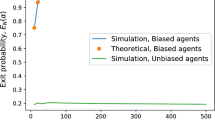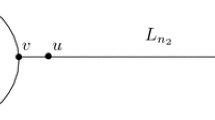Abstract
We consider a group of agents connected by a social network who participate in majority dynamics: each agent starts with an opinion in {−1, +1} and repeatedly updates it to match the opinion of the majority of its neighbors.
We assume that one of {−1, +1} is the “correct” opinion S, and consider a setting in which the initial opinions are independent conditioned on S, and biased towards it. They hence contain enough information to reconstruct S with high probability. We ask whether it is still possible to reconstruct S from the agents’ opinions after many rounds of updates.
While this is not the case in general, we show that indeed, for a large family of bounded degree graphs, information on S is retained by the process of majority dynamics.
Our proof technique yields novel combinatorial results on majority dynamics on both finite and infinite graphs, with applications to zero temperature Ising models.
Similar content being viewed by others
References
V. Bala and S. Goyal, Learning from neighbours, The Review of Economic Studies, 65 (1998), 595–621.
E. Berger, Dynamic monopolies of constant size, Journal of Combinatorial Theory, Series B 83 (2001), 191–200.
F. Camia, E. De Santis and C. Newman, Clusters and recurrence in the two-dimensional zero-temperature stochastic Ising model, The Annals of Applied Probability 12 (2002), 565–580.
E. De Santis and C, Newman, Convergence in energy-lowering (disordered) stochastic spin systems, Journal of Statistical Physics 110 (2003), 431–442.
G. Ellison and D. Fudenberg, Rules of thumb for social learning, Journal of Political Economy 101 (1993), 612–643.
L. R. Fontes, R. Schonmann and V. Sidoravicius, Stretched exponential fixation in stochastic Ising models at zero temperature, Communications in Mathematical Physics 228 (2002), 495–518.
D. Gale and S. Kariv, Bayesian learning in social networks, Games and Economic Behavior 45 (2003), 329–346.
Y, Ginosar and R, Holzman, The majority action on infinite graphs: strings and puppets, Discrete Mathematics 215 (2000), 59–72.
E. Goles and J, Olivos, Periodic behaviour of generalized threshold functions, Discrete Mathematics 30 (1980), 187–189.
C, D. Howard, Zero-temperature Ising spin dynamics on the homogeneous tree of degree three, Journal of Applied Probability 37 (2000), 736–747.
Y. Kanoria and A. Montanari, Majority dynamics on trees and the dynamic cavity method, The Annals of Applied Probability 21 (2011), 1694–1748.
D. Kempe, A. Dobra and J, Gehrke, Gossip-based computation of aggregate information, in Proceedings of the 44th Annual Symposium on Foundations of Computer Science, IEEE Computer Society, Washington, DC, 2003, pp. 482–491.
W. McCulloch and W. Pitts, A logical calculus of the ideas immanent in nervous activity, The Bulletin of Mathematical Biophysics 5 (1943), 115–133.
G. Moran, On the period-two-property of the majority operator in infinite graphs, Transactions of the American Mathematical Society 347 (1995), 1649–1667.
E. Mossel, J. Neeman and O. Tamuz, Majority dynamics and aggregation of information in social networks, Autonomous Agents and Multi-Agent Systems 28 (2014), 408–429.
E. Mossel, A. Sly and O. Tamuz, Strategic learning and the topology of social networks, (2012-08), ArXiv e-prints, 1209.5527.
D. Peleg, Size bounds for dynamic monopolies, Discrete Applied Mathematics 86 (1998), 263–273.
D. Shah, Gossip algorithms, Foundations and Trends in Networking, 3 (2009), 1–125.
R. Tessler and O. Louidor, Geometry and Dynamics in Zero Temperature Statistical Mechanics Models, (2010-08), ArXiv e-prints, 1008.5279.
Author information
Authors and Affiliations
Corresponding author
Additional information
Omer Tamuz is supported by ISF grant 1300/08, and is a recipient of the Google Europe Fellowship in Social Computing, and this research is supported in part by this Google Fellowship.
Rights and permissions
About this article
Cite this article
Tamuz, O., Tessler, R.J. Majority Dynamics and the Retention of Information. Isr. J. Math. 206, 483–507 (2015). https://doi.org/10.1007/s11856-014-1148-2
Received:
Revised:
Published:
Issue Date:
DOI: https://doi.org/10.1007/s11856-014-1148-2




